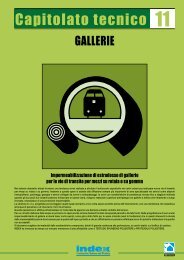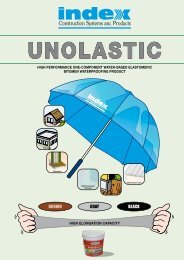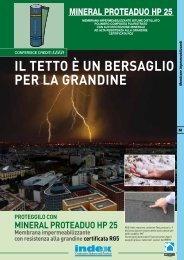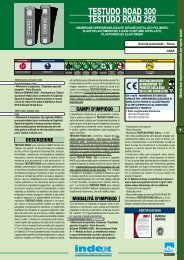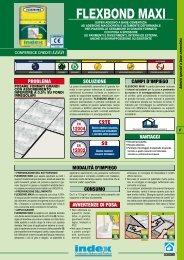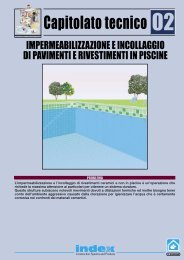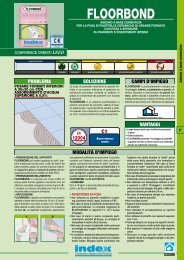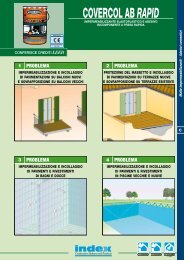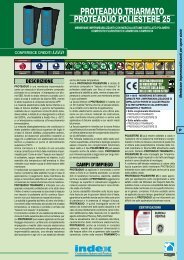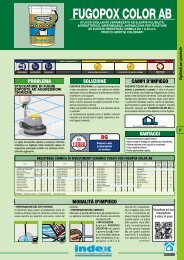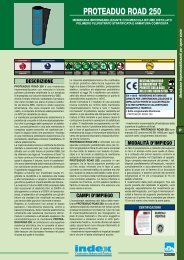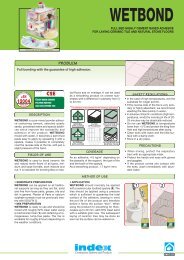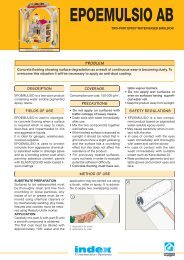guida alla posa delle membrane con adesivo a freddo - Index S.p.A.
guida alla posa delle membrane con adesivo a freddo - Index S.p.A.
guida alla posa delle membrane con adesivo a freddo - Index S.p.A.
You also want an ePaper? Increase the reach of your titles
YUMPU automatically turns print PDFs into web optimized ePapers that Google loves.
GUIDA ALLA POSA<br />
DELLE MEMBRANE FLEXTER TEX<br />
CON ADESIVO A FREDDO MASTIPOL<br />
socio del GBC Italia<br />
POSA A FREDDO SU CALCESTRUZZO<br />
POSA A FREDDO SU LEGNO<br />
POSA A FREDDO SU ISOLANTE TERMICO<br />
2. MASTIPOL<br />
3. FLEXTER BIARMATO TEX<br />
o MINERAL FLEXTER TEX<br />
2. MASTIPOL<br />
3. FLEXTER BIARMATO TEX<br />
o MINERAL FLEXTER TEX<br />
6. MASTIPOL<br />
5. Isolante<br />
termico<br />
4. MASTICOLL<br />
7. FLEXTER BIARMATO TEX<br />
o MINERAL FLEXTER TEX<br />
3. DEFEND o<br />
DEFEND ALU<br />
POLIESTERE<br />
2. MASTIPOL<br />
1. INDEVER<br />
1. SELFTENE BASE<br />
EP POLIESTERE<br />
1. INDEVER<br />
Ed. 2010-1<br />
GUIDA ALLA POSA DELLE MEMBRANE CON ADESIVO A FREDDO<br />
1
IL SISTEMA DI POSA CON ADESIVO A FREDDO<br />
MASTIPOL<br />
Le <strong>membrane</strong> impermeabilizzanti in bitume polimero per l’edilizia, in Italia, sono tradizionalmente<br />
incollate al piano di <strong>posa</strong> e sulle sovrapposizioni per rinvenimento a fiamma <strong>con</strong> un<br />
bruciatore a gas propano.<br />
Sulle superfici cementizie ed effettuata da operatori professionali <strong>con</strong>venientemente formati,<br />
la <strong>posa</strong> a fiamma non presenta rischi particolari di infortunio o di incendio, sicuramente<br />
inferiori al vecchio sistema di <strong>posa</strong> <strong>con</strong> bitume a caldo, mentre le precauzioni devono essere<br />
maggiori nel caso di <strong>posa</strong> sui pannelli di isolamento termico e sulle superfici combustibili<br />
come i tavolati di legno specie quando questi sono posti su di una intercapedine ventilata.<br />
Se a questo si aggiunge la <strong>con</strong>siderazione che la <strong>posa</strong> in totale aderenza <strong>con</strong> un <strong>adesivo</strong><br />
spalmato su tutta la superficie da rivestire garantisce in caso di ferita accidentale del manto<br />
impermeabile il passaggio di una minima quantità d’acqua circoscritta <strong>alla</strong> zona dell’ammaloramento<br />
e quindi molto più facilmente individuabile rispetto ad un manto libero o solo<br />
incollato parzialmente, si comprende come tale tipo di <strong>posa</strong> abbia avuto larga diffusione nei<br />
paesi del Nord Europa dove da più tempo vengono impiegati i pannelli isolanti e dove sono<br />
più diffuse le coperture in legno.<br />
Si possono quindi riassumere nei seguenti punti i vantaggi offerti d<strong>alla</strong> <strong>posa</strong> a <strong>freddo</strong> <strong>con</strong><br />
l’<strong>adesivo</strong> MASTIPOL:<br />
• Con gli adesivi a disposizione in quei cantieri dove vigono particolari misure di sicurezza<br />
oltre all’incollaggio <strong>delle</strong> <strong>membrane</strong> sulle parti a correre del tetto è possibile l’incollaggio<br />
a <strong>freddo</strong> sulle parti verticali e dei sormonti, tenendo pur sempre <strong>con</strong>to che la tenuta <strong>delle</strong><br />
giunzioni è comunque inferiore a quella che si realizza per saldatura a fiamma o ad aria<br />
calda. La saldatura ad aria calda dei sormonti e l’incollaggio sui rilievi di superficie modesta,<br />
quando è <strong>con</strong>sentita, elimina il problema della fiamma libera e <strong>delle</strong> bombole. Nella<br />
maggioranza dei casi dove non sono richieste restrizioni particolari anche nel caso di saldatura<br />
dei soli sormonti a fiamma e dell’incollaggio alle parti verticali <strong>con</strong> lo stessa metodologia,<br />
comunque si riduce notevolmente il rischio di incendio e di esplosione, sia per<br />
l’uso notevolmente circoscritto di fiamma libera, sia per la <strong>con</strong>temporanea notevole riduzione<br />
della quantità di bombole di gas propano presenti in cantiere.<br />
• L’incollaggio della membrana <strong>con</strong> una spalmatura di <strong>adesivo</strong> riduce notevolmente il passaggio<br />
dell’acqua in caso di lesione del manto e facilita l’individuazione dell’origine <strong>delle</strong><br />
perdite.<br />
• L’adesione in totale aderenza riduce notevolmente il tensionamento generato dagli sbalzi<br />
termici sui manti impermeabili a vista impedendo la formazione <strong>delle</strong> pieghe.<br />
Per ottenere una aderenza ottimale al piano di <strong>posa</strong> è essenziale che la membrana sia stata<br />
progettata allo scopo al fine di realizzare una forte e duratura adesione del collante.<br />
Le <strong>membrane</strong> per la <strong>posa</strong> a fiamma sono normalmente prodotte <strong>con</strong> la faccia inferiore rivestita<br />
da un film termoplastico che viene fuso <strong>con</strong> il cannello a gas propano durante le operazioni<br />
di applicazione, si tratta di una finitura superficiale che non offre sufficienti garanzie<br />
di adesione nel tempo alle colle a <strong>freddo</strong>, per questo le <strong>membrane</strong> FLEXTER TEX indicate<br />
per la <strong>posa</strong> <strong>con</strong> <strong>adesivo</strong> a <strong>freddo</strong> hanno la faccia inferiore rivestita <strong>con</strong> una finitura tessile in<br />
fibra polipropilenica, accoppiata ad alta temperatura, dotata di una elevata superficie specifica<br />
che garantisce un legame duraturo nel tempo.<br />
3. DEFEND o<br />
DEFEND ALU<br />
POLIESTERE<br />
POSA A FREDDO SU CALCESTRUZZO<br />
2. MASTIPOL<br />
1. INDEVER<br />
POSA A FREDDO SU LEGNO<br />
2. MASTIPOL<br />
1. SELFTENE BASE<br />
EP POLIESTERE<br />
6. MASTIPOL<br />
5. Isolante<br />
termico<br />
4. MASTICOLL<br />
2. MASTIPOL<br />
1. INDEVER<br />
3. FLEXTER BIARMATO TEX<br />
o MINERAL FLEXTER TEX<br />
3. FLEXTER BIARMATO TEX<br />
o MINERAL FLEXTER TEX<br />
POSA A FREDDO SU ISOLANTE TERMICO<br />
7. FLEXTER BIARMATO TEX<br />
o MINERAL FLEXTER TEX<br />
• Elimina/riduce il rischio di incendio e di<br />
esplosione<br />
VANTAGGI<br />
• La spalmatura di <strong>adesivo</strong> riduce notevolmente<br />
il passaggio dell’acqua in caso di<br />
lesione del manto e facilita l’individuazione<br />
dell’origine <strong>delle</strong> perdite<br />
• L’adesione in totale aderenza riduce notevolmente<br />
il tensionamento generato dagli<br />
sbalzi termici sui manti impermeabili a vista<br />
impedendo la formazione <strong>delle</strong> pieghe<br />
NO<br />
NO<br />
NO<br />
MASTIPOL<br />
MASTIPOL<br />
MASTIPOL<br />
2 GUIDA ALLA POSA DELLE MEMBRANE CON ADESIVO A FREDDO
LE MEMBRANE IMPERMEABILIZZANTI<br />
FLEXTER TEX<br />
Le <strong>membrane</strong> della serie FLEXTER TEX sono costituite da una mescola ad inversione di fase elastoplastomerica a base di bitumi distillati selezionati, polimeri plastomerici<br />
ed elastomerici poliolefinici, dove la fase <strong>con</strong>tinua è costituita d<strong>alla</strong> componente polimerica, per questo la mescola bitume-polimero è resistente alle basse<br />
e alle alte temperature, caratteristiche che mantiene a lungo nel tempo.<br />
Le <strong>membrane</strong> della serie FLEXTER TEX sono caratterizzate d<strong>alla</strong> finitura tessile della faccia inferiore costituita<br />
dal tessuto non tessuto di fibre polipropileniche TEXFLAMINA accoppiato ad alta temperatura <strong>alla</strong><br />
membrana in bitume-polimero.<br />
Si ottiene in tal modo una adesione tenace del tessuto <strong>alla</strong> membrana che per la sua natura fibrosa aumenta<br />
notevolmente la superficie specifica di aggrappo agli adesivi e costituisce un efficacissimo intermediario di<br />
adesione che incrementa la resistenza <strong>alla</strong> spellatura della membrana incollata.<br />
La finitura TEXFLAMINA nasce per l’incollaggio <strong>con</strong> l’<strong>adesivo</strong> a <strong>freddo</strong> MASTIPOL ma è efficace anche<br />
nel caso di incollaggio <strong>con</strong> bitume ossidato fuso steso a caldo. La finitura TEXFLAMINA <strong>con</strong>sente un<br />
incollaggio durevole e più elevato di quello che si ottiene sulle superfici <strong>delle</strong> <strong>membrane</strong> talcate o sabbiate<br />
e <strong>con</strong>trariamente a queste la forza di adesione aumenta nel tempo. TEXFLAMINA, quando non viene incollato,<br />
funge da strato di scorrimento a basso coefficiente di attrito, migliore della talcatura, della sabbiatura e<br />
anche dei film plastici normalmente accoppiati <strong>alla</strong> faccia inferiore <strong>delle</strong> <strong>membrane</strong> bituminose.<br />
Faccia<br />
inferiore<br />
Texflamina<br />
Faccia<br />
superiore<br />
talcata<br />
PEEL TEST (forza di adesione N/50 mm)<br />
Finitura superficiale Incollaggio su cls <strong>con</strong> bitume ossidato fuso Incollaggio su cls <strong>con</strong> MASTIPOL<br />
della membrana Nuovo Dopo invecchiamento (*) Nuovo Dopo invecchiamento (*)<br />
Sabbia/talco 33 24 38 30<br />
Texflamina 40 85 45 76<br />
(*) Invecchiamento: 25 d a 70°C.<br />
Texflamina<br />
Supporto<br />
Adesivo<br />
Membrana<br />
Fra le <strong>membrane</strong> della serie FLEXTER TEX si distingue FLEXTER BIARMATO TEX una membrana biarmata <strong>con</strong> tessuto non tessuto di poliestere accoppiato a feltro<br />
di vetro posizionato nella parte superiore dello spessore della membrana ma pur sempre ricoperto da un sottile strato di bitume polimero che <strong>con</strong>sente una agevole<br />
e duratura saldatura dei sormonti. La biarmatura è il sistema più antico ma ancora il più efficace per garantire la migliore stabilità dimensionale al calore della membrana<br />
specie nella fase iniziale di asciugatura dell’<strong>adesivo</strong> quando questa è incollata a vista su un forte isolamento termico.<br />
La stabilizzazione <strong>con</strong> feltro di vetro influisce positivamente anche sul comportamento termomeccanico della membrana a bassa temperatura; riducendone la <strong>con</strong>trazione<br />
termica verso il centro geometrico della copertura, in sinergia <strong>con</strong> l’incollaggio in totale aderenza, riduce la formazione di tensionamenti e pieghe perimetrali<br />
del manto impermeabile sugli angoli e al piede dei rilievi del tetto.<br />
Una stabilità dimensionale analoga <strong>alla</strong> biarmatura è offerta d<strong>alla</strong> triarmatura della membrana MINERAL FLEXTER FR TRIATEX costituita da un feltro di vetro compreso<br />
fra due strati di tessuto non tessuto di poliestere che <strong>con</strong>tribuisce come nel caso della versione FR (Fire Resistance) di BIARMATO <strong>alla</strong> resistenza al fuoco della<br />
membrana, in azione sinergica <strong>con</strong> l’apposito additivo aggiunto <strong>alla</strong> mescola bitume polimero di queste versioni.<br />
L’additivo antifiamma <strong>delle</strong> versioni FR è innocuo, è di natura minerale, non <strong>con</strong>tiene cloro, e durante la combustione non libera gas tossici.<br />
Le <strong>membrane</strong> MINERAL FLEXTER TEX e FLEXTER 25/5 TEX hanno una armatura composita in tessuto non tessuto di poliestere stabilizzato <strong>con</strong> fibra di vetro nel<br />
senso longitudinale, quello maggiormente soggetto al problema del ritiro a caldo <strong>delle</strong> <strong>membrane</strong> esposte al sole, al fine di evitare il problema dello scorrimento <strong>delle</strong><br />
giunzioni di testa. L’armatura e lo spessore del tipo 25/5 sono più <strong>con</strong>sistenti per <strong>con</strong>sentirne l’impiego anche nelle coperture carrabili e nei lavori più impegnativi.<br />
Infine le versioni FLEXTER BIARMATO TEX e FLEXTER 25/5 TEX per l’impiego come manti impermeabili di coperture a “verde” possono essere additivate <strong>con</strong><br />
Preventol B2, l’additivo antiradice <strong>delle</strong> <strong>membrane</strong> impermeabilizzanti per i giardini pensili.<br />
CERTIFICAZIONI<br />
Le <strong>membrane</strong> della serie<br />
FLEXTER TEX sono certificate<br />
dall’Agrement dell’Istituto<br />
belga UBAtc <strong>con</strong> il n°<br />
ATG/1616 e quindi rispondono<br />
sia ai requisiti <strong>delle</strong> norme<br />
europee EN per la marcatura<br />
CE sia ai più severi requisiti<br />
prestazionali dell’UEAtc.<br />
Le versioni FR superano la<br />
prova di resistenza al fuoco<br />
se<strong>con</strong>do ENV 1187/1 e<br />
sono classificate <strong>con</strong>forme<br />
EN13501-5: B roof-t1.<br />
È stata certificata anche<br />
la resistenza al vento di<br />
FLEXTER BIARMATO incollato<br />
<strong>con</strong> l’<strong>adesivo</strong> MASTIPOL.<br />
Per le <strong>membrane</strong> FLEXTER<br />
BIARMATO FR e MINERAL<br />
FLEXTER FR, (distribuite in<br />
Olanda sotto la denominazione<br />
rispettivamente di WEDEFLEX<br />
CRT, MINERAL WEDEFLEX<br />
CRT e WEDEFLEX D4),<br />
l’Istituto di ricerca olandese<br />
BDA, dopo una verifica dei<br />
lavori eseguiti nel corso degli<br />
anni, ne ha certificato una<br />
durabilità di almeno 30 anni.<br />
FLEXTER BIARMATO TEX e<br />
FLEXTER 25/5 TEX additivate<br />
<strong>con</strong> Preventol B2 sono<br />
certificate dallIstituto tedesco<br />
FORSCHUNGSANSTALT<br />
GEISENHEIM <strong>con</strong> il metodo<br />
FLL <strong>con</strong>forme norma EN-<br />
13948.<br />
GUIDA ALLA POSA DELLE MEMBRANE CON ADESIVO A FREDDO<br />
3
I RIVESTIMENTO ELASTOMOERO-BITUMINOSO ALL’ACQUA<br />
GB WATER-BASED ELASTOMER/BITUMINOUS COATING<br />
D RIVESTIMENTO ELASTOMOERO-BITUMINOSO ALL’ACQUA<br />
F WATER-BASED ELASTOMER/BITUMINOUS COATING<br />
NL WATER-BASED ELASTOMER/BITUMINOUS COATING<br />
TO BE MEHANICALLY<br />
SPRAY<br />
TO BE APPLIED BY<br />
MIXED<br />
APPLICATION PLASTERING TROWEL<br />
ONE-COMPONENT<br />
WATER BASED<br />
A H 2 O<br />
MONOCOMPONENTE VEICOLO ACQUA<br />
MESCOLARE<br />
APPLICARE A<br />
MECCANICAMENTE<br />
SPRUZZO<br />
KEEP AWAY<br />
FROM FROST<br />
TO BE APPLIED TO BE APPLIED MINIMUM APPLICATION<br />
BY BRUSH<br />
BY ROLLER<br />
TEMPERATURE<br />
+ 5°C<br />
APPLICARE CON APPLICARE CON TEMPERATURA MIN.<br />
PENNELLO<br />
RULLO<br />
DI APPLICAZIONE<br />
37060 Castel d’Azzano - Verona - ITALY<br />
APPLICARE CON<br />
FRATTAZZO<br />
USE SUITABLE<br />
PROTECTION<br />
STOCCAGGIO:<br />
UTILIZZARE DISPOSITIVI<br />
TEME IL GELO DI PROTEZIONE INDIVIDUALI<br />
USO PROFESSIONALE • FOR PROFESSIONALE USE ONLY<br />
GLI ADESIVI<br />
MASTIPOL<br />
MASTIPOL è un <strong>adesivo</strong> bituminoso a base di particolari bitumi, elastomeri, solventi e cariche<br />
minerali.<br />
È formulato in modo da rendere efficace l’aderenza della membrana bitume polimero<br />
su calcestruzzo e legno, vecchi manti bituminosi, poliuretano espanso, lana di<br />
roccia e perlite espansa, quest’ultime <strong>con</strong> la faccia superiore prerivestita di bitume. Nel caso di<br />
<strong>posa</strong> su polistirolo espanso il pannello deve essere già protetto <strong>con</strong> un foglio bituminoso talcato<br />
o sabbiato <strong>con</strong> cimose che proteggano le linee di accostamento dei pannelli dalle colature<br />
dell’<strong>adesivo</strong>.<br />
Si presenta come una pasta facilmente spatolabile e si stende in modo uniforme sul piano di <strong>posa</strong><br />
usando l’apposito stenditore.<br />
Ottura le cavillature del piano di <strong>posa</strong> fornendo uno strato impermeabile intermedio fra il supporto<br />
e la membrana impermeabilizzante.<br />
MASTIPOL è impiegato per incollare le <strong>membrane</strong> bitume polimero su coperture piane di strutture civili e industriali <strong>con</strong> pendenza massima<br />
del 5%. Per pendenze superiori al 5% l’incollaggio deve essere integrato <strong>con</strong> fissaggio meccanico.<br />
Il <strong>con</strong>sumo di MASTIPOL è circa 1 kg/m 2 ca. e dipende d<strong>alla</strong> rugosità del supporto.<br />
I supporti porosi come il calcestruzzo e i vecchi manti bituminosi vanno preparati <strong>con</strong> una mano di primer bituminoso INDEVER.<br />
Le superfici di <strong>posa</strong> devono essere lisce e regolari, perfettamente pulite da parti friabili ed in distacco, asciutte ed esenti da olio e grassi.<br />
MASTIPOL non deve essere usato per incollare le sovrapposizioni della membrana e si <strong>con</strong>siglia l’applicazione a temperature del supporto<br />
superiori a +5°C.<br />
MASTIPOL<br />
Partita kg e<br />
I<br />
• CAMPI D’IMPIEGO.<br />
è <strong>con</strong>sigliato per impermeabilizzare muri di fondazione in calcestruzzo.<br />
• MODALITÁ D’IMPIEGO.<br />
La superficie da trattare deve essere asciutta, pulita e priva di parti di distacco. Le<br />
parti friabili vanno eliminate e ricostruite. Per l’adesività sulle superfici porose e<br />
secche, è <strong>con</strong>sigliabile la stesura una mano di diluita al 30% <strong>con</strong> acqua. va<br />
mescolato prima dell’uso <strong>con</strong> trapani mmani di prodotto. Non eccedere nel <strong>con</strong>sumo<br />
per mano per non l’evaporazione dell’acqua <strong>con</strong>tenuta nel prodotto applicato.<br />
• CONSUMI.<br />
0,500 kg/m 2 per mano.<br />
GB<br />
• APPLICATIONS.<br />
is recommended to waterproof foundations walls made in <strong>con</strong>crete.<br />
• DIRECTIONS.<br />
The surface to be treated has to be dry, clean and with no detaching parts. Weak<br />
parts have to be eliminated and replaced with new material. In order to improve<br />
the adhesive onto porous and dry surfaces, it is recommended to previously spread<br />
a first layer <strong>con</strong>sisting in a 30% water-diluted . has to be mixed before use with<br />
mechanic drills. Application can be made with brushes, rollers or spraying devices.<br />
• CONSUMPTION.<br />
0.5 kg/square metre/year.<br />
D<br />
• APPLICATIONS.<br />
is recommended to waterproof foundations walls made in <strong>con</strong>crete.<br />
• DIRECTIONS.<br />
The surface to be treated has to be dry, clean and with no detaching parts. Weak<br />
parts have to be eliminated and replaced with new material. In order to improve<br />
the adhesive onto porous and dry surfaces, it is recommended to previously spread<br />
a first layer <strong>con</strong>sisting in a 30% water-diluted . has to be mixed before use with<br />
mechanic drills. Application can be made with brushes, rollers or spraying devices.<br />
• CONSUMPTION.<br />
0.5 kg/square metre/year.<br />
F<br />
• APPLICATIONS.<br />
is recommended to waterproof foundations walls made in <strong>con</strong>crete.<br />
• DIRECTIONS.<br />
The surface to be treated has to be dry, clean and with no detaching parts. Weak<br />
parts have to be eliminated and replaced with new material. In order to improve<br />
the adhesive onto porous and dry surfaces, it is recommended to previously spread<br />
a first layer <strong>con</strong>sisting in a 30% water-diluted . has to be mixed before use with<br />
mechanic drills. Application can be made with brushes, rollers or spraying devices.<br />
• CONSUMPTION.<br />
0.5 kg/square metre/year.<br />
NL<br />
• APPLICATIONS.<br />
is recommended to waterproof foundations walls made in <strong>con</strong>crete.<br />
• DIRECTIONS.<br />
The surface to be treated has to be dry, clean and with no detaching parts. Weak<br />
parts have to be eliminated and replaced with new material. In order to improve<br />
the adhesive onto porous and dry surfaces, it is recommended to previously spread<br />
a first layer <strong>con</strong>sisting in a 30% water-diluted . has to be mixed before use with<br />
mechanic drills. Application can be made with brushes, rollers or spraying devices.<br />
• CONSUMPTION.<br />
0.5 kg/square metre/year.<br />
POSA A FREDDO SU CALCESTRUZZO POSA A FREDDO SU LEGNO POSA A FREDDO SU ISOLANTE TERMICO<br />
MASTIPOL<br />
MASTIPOL<br />
MASTIPOL<br />
CARATTERISTICHE TECNICHE<br />
MASTIPOL<br />
Aspetto<br />
pastoso<br />
Colore<br />
Nero<br />
Peso specifico massa volumica<br />
a 23°C (UNI-EN-ISO 2811-1)<br />
1,30±0,10 kg/litro<br />
Residuo secco (m/m)<br />
(UNI-EN-ISO 3251) 80%±4%<br />
Viscosità <strong>con</strong> coppa Ford<br />
n. 6 a 23°C (UNI-EN-ISO 2431) 20’±3’<br />
Punto di infiammabilità<br />
(vaso chiuso) (ASTM D 3828-87)<br />
>23°C<br />
Stoccaggio nelle <strong>con</strong>fezioni originali<br />
12 mesi<br />
4 GUIDA ALLA POSA DELLE MEMBRANE CON ADESIVO A FREDDO
ONE-COMPONENT<br />
WATER BASED<br />
MONOCOMPONENTE VEICOLO ACQUA<br />
TO BE APPLIED TO BE APPLIED<br />
BY BRUSH<br />
BY ROLLER<br />
APPLICARE CON APPLICARE CON<br />
PENNELLO<br />
RULLO<br />
TO BE MEHANICALLY<br />
SPRAY<br />
MIXED<br />
APPLICATION<br />
APPLICARE A<br />
SPRUZZO<br />
MESCOLARE<br />
MECCANICAMENTE<br />
MINIMUM APPLICATION KEEP AWAY<br />
TEMPERATURE<br />
FROM FROST<br />
TO BE APPLIED BY<br />
PLASTERING TROWEL<br />
APPLICARE CON<br />
FRATTAZZO<br />
USE SUITABLE<br />
PROTECTION<br />
TEMPERATURA MIN. STOCCAGGIO:<br />
UTILIZZARE DISPOSITIVI<br />
DI APPLICAZIONE<br />
TEME IL GELO DI PROTEZIONE INDIVIDUALI<br />
I RIVESTIMENTO ELASTOMOERO-BITUMINOSO ALL’ACQUA<br />
GB WATER-BASED ELASTOMER/BITUMINOUS COATING<br />
D RIVESTIMENTO ELASTOMOERO-BITUMINOSO ALL’ACQUA<br />
F WATER-BASED ELASTOMER/BITUMINOUS COATING<br />
NL WATER-BASED ELASTOMER/BITUMINOUS COATING<br />
TO BE MEHANICALLY<br />
SPRAY<br />
TO BE APPLIED BY<br />
ONE-COMPONENT<br />
WATER BASED<br />
MIXED<br />
APPLICATION PLASTERING TROWEL<br />
A H 2 O<br />
MONOCOMPONENTE VEICOLO ACQUA<br />
MESCOLARE<br />
APPLICARE A<br />
APPLICARE CON<br />
MECCANICAMENTE<br />
SPRUZZO<br />
FRATTAZZO<br />
TO BE APPLIED TO BE APPLIED MINIMUM APPLICATION KEEP AWAY<br />
USE SUITABLE<br />
BY BRUSH<br />
BY ROLLER<br />
TEMPERATURE<br />
FROM FROST<br />
PROTECTION<br />
+ 5°C<br />
APPLICARE CON APPLICARE CON TEMPERATURA MIN. STOCCAGGIO:<br />
UTILIZZARE DISPOSITIVI<br />
PENNELLO<br />
RULLO<br />
DI APPLICAZIONE<br />
TEME IL GELO DI PROTEZIONE INDIVIDUALI<br />
37060 Castel d’Azzano - Verona - ITALY<br />
USO PROFESSIONALE • FOR PROFESSIONALE USE ONLY<br />
GLI ADESIVI<br />
HEADCOLL<br />
Adesivo bituminoso al solvente a base di bitumi e resine selezionate, solventi, cariche minerali,<br />
formulato specificatamente per le sovrapposizioni <strong>delle</strong> <strong>membrane</strong> bitume polimero e che può<br />
essere usato anche per incollare la membrana sulle parti verticali del tetto.<br />
L’<strong>adesivo</strong> può essere usato anche come mastice per riparare le bolle dei vecchi manti bituminosi<br />
prima della <strong>posa</strong> della membrana <strong>con</strong> l’<strong>adesivo</strong> Mastipol.<br />
Contiene sia resine speciali che rispetto ai normali collanti bituminosi aumentano il potere legante,<br />
sia solventi a rapida evaporazione che accelerano l’asciugamento del prodotto. Il <strong>con</strong>sumo indicativo<br />
del prodotto è di circa 0.8-1 kg/m 2 .<br />
HEADCOLL<br />
CARATTERISTICHE TECNICHE<br />
HEADCOLL<br />
Aspetto<br />
pastoso<br />
Colore<br />
Nero<br />
Peso specifico massa volumica<br />
a 23°C (UNI-EN-ISO 2811-1)<br />
1,40±0,10 kg/litro<br />
Residuo secco (m/m)<br />
(UNI-EN-ISO 3251) 90%±3%<br />
Viscosità a 20° C.<br />
100.000±1.000 cps<br />
Tempo di essiccazione<br />
fuori polvere<br />
3 ore<br />
Stoccaggio nelle <strong>con</strong>fezioni originali<br />
12 mesi<br />
MASTICOLL<br />
È l’<strong>adesivo</strong> usato per incollare a <strong>freddo</strong> i pannelli di isolamento termico che completa la gamma di adesivi<br />
necessaria per un ciclo completo di incollaggio a <strong>freddo</strong> di tutta la stratigrafia di copertura.<br />
MASTICOLL può essere impiegato per incollare pannelli di polistirolo espanso, espanso estruso, poliuretano<br />
espanso, perlite e fibre cellulosiche sulle coperture edilizie fino ad una pendenza massima del<br />
5%. Per pendenze superiori l’incollaggio sarà integrato <strong>con</strong> un fissaggio meccanico. Per il fissaggio dei<br />
pannelli si stendono dei gnocchi di <strong>adesivo</strong> sul lato inferiore di ogni pannello in corrispondenza degli<br />
angoli e sul centro dello stesso per un <strong>con</strong>sumo di 0,8 kg/m 2 ca.<br />
Successivamente il pannello viene <strong>posa</strong>to su una barriera al vapore bituminosa <strong>con</strong> la faccia superiore<br />
talcata, sabbiata o rivestita <strong>con</strong> Texflamina pressandolo <strong>con</strong> i piedi.<br />
MASTICOLL<br />
Partita kg e<br />
I<br />
• CAMPI D’IMPIEGO.<br />
è <strong>con</strong>sigliato per impermeabilizzare muri di fondazione in calcestruzzo.<br />
• MODALITÁ D’IMPIEGO.<br />
La superficie da trattare deve essere asciutta, pulita e priva di parti di distacco. Le<br />
parti friabili vanno eliminate e ricostruite. Per l’adesività sulle superfici porose e<br />
secche, è <strong>con</strong>sigliabile la stesura una mano di diluita al 30% <strong>con</strong> acqua. va<br />
mescolato prima dell’uso <strong>con</strong> trapani mmani di prodotto. Non eccedere nel <strong>con</strong>sumo<br />
per mano per non l’evaporazione dell’acqua <strong>con</strong>tenuta nel prodotto applicato.<br />
• CONSUMI.<br />
0,500 kg/m 2 per mano.<br />
GB<br />
• APPLICATIONS.<br />
is recommended to waterproof foundations walls made in <strong>con</strong>crete.<br />
• DIRECTIONS.<br />
The surface to be treated has to be dry, clean and with no detaching parts. Weak<br />
parts have to be eliminated and replaced with new material. In order to improve<br />
the adhesive onto porous and dry surfaces, it is recommended to previously spread<br />
a first layer <strong>con</strong>sisting in a 30% water-diluted . has to be mixed before use with<br />
mechanic drills. Application can be made with brushes, rollers or spraying devices.<br />
• CONSUMPTION.<br />
0.5 kg/square metre/year.<br />
D<br />
• APPLICATIONS.<br />
is recommended to waterproof foundations walls made in <strong>con</strong>crete.<br />
• DIRECTIONS.<br />
The surface to be treated has to be dry, clean and with no detaching parts. Weak<br />
parts have to be eliminated and replaced with new material. In order to improve<br />
the adhesive onto porous and dry surfaces, it is recommended to previously spread<br />
a first layer <strong>con</strong>sisting in a 30% water-diluted . has to be mixed before use with<br />
mechanic drills. Application can be made with brushes, rollers or spraying devices.<br />
• CONSUMPTION.<br />
0.5 kg/square metre/year.<br />
F<br />
• APPLICATIONS.<br />
is recommended to waterproof foundations walls made in <strong>con</strong>crete.<br />
• DIRECTIONS.<br />
The surface to be treated has to be dry, clean and with no detaching parts. Weak<br />
parts have to be eliminated and replaced with new material. In order to improve<br />
the adhesive onto porous and dry surfaces, it is recommended to previously spread<br />
a first layer <strong>con</strong>sisting in a 30% water-diluted . has to be mixed before use with<br />
mechanic drills. Application can be made with brushes, rollers or spraying devices.<br />
• CONSUMPTION.<br />
0.5 kg/square metre/year.<br />
NL<br />
• APPLICATIONS.<br />
is recommended to waterproof foundations walls made in <strong>con</strong>crete.<br />
• DIRECTIONS.<br />
The surface to be treated has to be dry, clean and with no detaching parts. Weak<br />
parts have to be eliminated and replaced with new material. In order to improve<br />
the adhesive onto porous and dry surfaces, it is recommended to previously spread<br />
a first layer <strong>con</strong>sisting in a 30% water-diluted . has to be mixed before use with<br />
mechanic drills. Application can be made with brushes, rollers or spraying devices.<br />
• CONSUMPTION.<br />
0.5 kg/square metre/year.<br />
POSA DELL’ISOLANTE TERMICO<br />
MASTICOLL<br />
CARATTERISTICHE TECNICHE<br />
MASTICOLL<br />
Aspetto<br />
liquido vischioso<br />
Colore<br />
Nero<br />
Peso specifico massa volumica<br />
a 23°C (UNI-EN-ISO 2811-1)<br />
1,40±0,10 kg/litro<br />
Residuo secco (m/m)<br />
(UNI-EN-ISO 3251) 85%±5%<br />
Viscosità a 20° C.<br />
40.000±1.000 cps<br />
Tempo di presa (indurito)<br />
48 ore<br />
Punto di infiammabilità<br />
a vaso chiuso (ASTM D 3828-87)<br />
>+23°C<br />
Stoccaggio nelle <strong>con</strong>fezioni originali<br />
12 mesi<br />
GUIDA ALLA POSA DELLE MEMBRANE CON ADESIVO A FREDDO<br />
5
CAMPI D’<br />
TETTO PIANO PEDONABILE<br />
7. FLEXTER BIARMATO TEX<br />
6. MASTIPOL<br />
5. Isolante<br />
termico<br />
4. MASTICOLL<br />
8. Strato di<br />
separazione<br />
9. Pavimento in cls<br />
STRATIGRAFIA<br />
1. Supporto cementizio<br />
2. INDEVER PRIMER E<br />
3. SELFTENE BASE EP<br />
POLIESTERE<br />
4. MASTICOLL<br />
5. Isolante termico<br />
6. MASTIPOL<br />
7. FLEXTER BIARMATO TEX<br />
8. Strato di separazione<br />
9. Pavimento in cls<br />
6. Strato di<br />
separazione<br />
5. Isolante<br />
filtrante<br />
7. Pavimento galleggiante<br />
termico<br />
POLISTIROLO<br />
ESTRUSO<br />
4. FLEXTER<br />
BIARMATO TEX<br />
STRATIGRAFIA<br />
1. Supporto cementizio<br />
2. INDEVER<br />
3. MASTIPOL<br />
4. FLEXTER BIARMATO TEX<br />
5. Isolante termico POLISTIROLO<br />
ESTRUSO<br />
6. Strato di separazione filtrante<br />
7. Pavimento galleggiante<br />
3. SELFTENE<br />
BASE EP<br />
POLIESTERE<br />
2. INDEVER PRIMER E<br />
1. Supporto<br />
cementizio<br />
3. MASTIPOL<br />
2. INDEVER<br />
1. Supporto<br />
cementizio<br />
6. Isolante<br />
termico<br />
5. MASTICOLL<br />
7. MASTIPOL<br />
8. FLEXTER<br />
BIARMATO TEX<br />
9. Pavimento galleggiante<br />
STRATIGRAFIA<br />
1. Supporto cementizio<br />
2. INDEVER<br />
3. MASTIPOL<br />
4. DEFEND o DEFEND ALU<br />
POLIESTERE<br />
5. MASTICOLL<br />
6. Isolante termico<br />
7. MASTIPOL<br />
8. FLEXTER BIARMATO TEX<br />
9. Pavimento galleggiante<br />
4. DEFEND o<br />
DEFEND ALU<br />
POLIESTERE<br />
3. MASTIPOL<br />
2. INDEVER<br />
1. Supporto<br />
cementizio<br />
6 GUIDA ALLA POSA DELLE MEMBRANE CON ADESIVO A FREDDO
IMPIEGO<br />
TETTO PIANO NON PEDONABILE<br />
SU CALCESTRUZZO<br />
• senza isolante termico<br />
SU LEGNO<br />
• senza isolante termico<br />
3. MASTIPOL<br />
4. FLEXTER BIARMATO TEX<br />
o MINERAL FLEXTER TEX<br />
STRATIGRAFIA<br />
1. Supporto cementizio<br />
2. INDEVER<br />
3. MASTIPOL<br />
4. FLEXTER BIARMATO TEX o<br />
MINERAL FLEXTER TEX<br />
3. MASTIPOL<br />
4. FLEXTER BIARMATO TEX<br />
o MINERAL FLEXTER TEX<br />
STRATIGRAFIA<br />
1. Supporto in legno<br />
2. SELFTENE BASE EP<br />
POLIESTERE<br />
3. MASTIPOL<br />
4. FLEXTER BIARMATO TEX o<br />
MINERAL FLEXTER TEX<br />
2. INDEVER<br />
1. Supporto<br />
cementizio<br />
2. SELFTENE BASE<br />
EP POLIESTERE<br />
1. Supporto<br />
in legno<br />
• <strong>con</strong> isolante termico<br />
7. MASTIPOL<br />
6. Isolante<br />
termico<br />
5. MASTICOLL<br />
8. FLEXTER BIARMATO TEX<br />
o MINERAL FLEXTER TEX<br />
STRATIGRAFIA<br />
1. Supporto cementizio<br />
2. INDEVER<br />
3. MASTIPOL<br />
4. DEFEND o DEFEND ALU<br />
POLIESTERE<br />
5. MASTICOLL<br />
6. Isolante termico<br />
7. MASTIPOL<br />
8. FLEXTER BIARMATO TEX o<br />
MINERAL FLEXTER TEX<br />
5. MASTIPOL<br />
4. Isolante<br />
termico<br />
3. MASTICOLL<br />
6. FLEXTER BIARMATO FR<br />
STRATIGRAFIA<br />
1. OSB/Plywood<br />
2. SELFTENE BASE EP<br />
POLIESTERE<br />
3. MASTICOLL<br />
4. Isolante termico<br />
5. MASTIPOL<br />
6. FLEXTER BIARMATO FR<br />
4. DEFEND o<br />
DEFEND ALU<br />
POLIESTERE<br />
3. MASTIPOL<br />
2. INDEVER<br />
1. Supporto<br />
cementizio<br />
2. SELFTENE BASE<br />
EP POLIESTERE<br />
1. OSB/Plywood<br />
4. Isolante<br />
termico<br />
5. MASTIPOL<br />
6. FLEXTER BIARMATO TEX<br />
o MINERAL FLEXTER TEX<br />
STRATIGRAFIA<br />
1. Supporto cementizio<br />
2. INDEVER<br />
3a. TECTENE BV STRIP<br />
3b. PROMINENT<br />
4. Isolante termico<br />
5. MASTIPOL<br />
6. FLEXTER BIARMATO TEX o<br />
MINERAL FLEXTER TEX<br />
4. Isolante<br />
termico<br />
3. MASTICOLL<br />
5. MASTIPOL<br />
6. MINERAL FLEXTER TEX<br />
STRATIGRAFIA<br />
1. Tavolato in legno massello<br />
2. ELASTOCENE POLIESTERE<br />
chiodato<br />
3. MASTICOLL<br />
4. Isolante termico<br />
5. MASTIPOL<br />
6. MINERAL FLEXTER TEX<br />
3a. TECTENE BV STRIP<br />
3b. PROMINENT<br />
2. INDEVER<br />
1. Supporto<br />
cementizio<br />
2. ELASTOCENE<br />
POLIESTERE<br />
chiodato<br />
1. Tavolato in<br />
legno massello<br />
3. ISOBASE<br />
PSE<br />
4. MASTIPOL<br />
5. FLEXTER BIARMATO TEX<br />
o MINERAL FLEXTER TEX<br />
STRATIGRAFIA<br />
1. Tavolato in legno massello<br />
2. SELFTENE BIADESIVO ALU/<br />
POLIESTERE<br />
3. ISOBASE PSE<br />
4. MASTIPOL<br />
5 FLEXTER BIARMATO TEX o<br />
MINERAL FLEXTER TEX<br />
2. SELFTENE<br />
BIADESIVO<br />
ALU/POLIESTERE<br />
1. Tavolato in<br />
legno massello<br />
GUIDA ALLA POSA DELLE MEMBRANE CON ADESIVO A FREDDO<br />
7
CAMPI D’<br />
LAMIERA GRECATA<br />
RIFACIMENTI<br />
5. MASTIPOL<br />
4. Isolante<br />
termico fissato<br />
meccanicamente<br />
3. Fissaggio<br />
provvisorio del<br />
pannello <strong>con</strong><br />
MASTICOLL<br />
al centro del pannello<br />
2. SELFTENTE BASE<br />
EP ALU/POLIESTERE<br />
6. FLEXTER BIARMATO TEX<br />
o MINERAL FLEXTER TEX<br />
1. Lamiera<br />
grecata<br />
STRATIGRAFIA<br />
1. Lamiera grecata<br />
2. SELFTENE BASE EP<br />
POLIESTERE<br />
3. Fissaggio provvisorio del<br />
pannello <strong>con</strong> MASTICOLL al<br />
centro del pannello<br />
4. Isolante termico fissato<br />
meccanicamente<br />
5. MASTIPOL<br />
6. FLEXTER BIARMATO TEX o<br />
MINERAL FLEXTER TEX<br />
3. MASTIPOL<br />
2. Manto<br />
esistente<br />
4. FLEXTER BIARMATO TEX<br />
1. Supporto<br />
cementizio<br />
STRATIGRAFIA<br />
1. Supporto cementizio<br />
2. Manto esistente<br />
3. MASTIPOL<br />
4. FLEXTER BIARMATO TEX<br />
BONIFICA DELLE COPERTURE<br />
IN CEMENTO AMIANTO<br />
4. MASTIPOL<br />
3. ISOLONDULA<br />
5. MINERAL FLEXTER TEX<br />
STRATIGRAFIA<br />
1. Cemento amianto<br />
2. ELASTOLIQUID PUR<br />
3. ISOLONDULA<br />
4. MASTIPOL<br />
5. MINERAL FLEXTER TEX<br />
2. ELASTOLIQUID PUR<br />
1. Cemento amianto<br />
8 GUIDA ALLA POSA DELLE MEMBRANE CON ADESIVO A FREDDO
IMPIEGO<br />
PARKING<br />
GIARDINO PENSILE<br />
9. Strato di separazione<br />
• verde intensivo<br />
8. FLEXTER 25/5 TEX<br />
7. MASTIPOL<br />
6. Isolante termico<br />
PERLITE ESPANSA<br />
5. MASTICOLL<br />
4. DEFEND o<br />
DEFEND ALU<br />
POLIESTERE<br />
3. MASTIPOL<br />
10. Pavimento in cls<br />
STRATIGRAFIA<br />
1. Supporto cementizio<br />
2. INDEVER<br />
3. MASTIPOL<br />
4. DEFEND o DEFEND ALU<br />
POLIESTERE<br />
5. MASTICOLL<br />
6. Isolante termico PERLITE<br />
ESPANSA<br />
7. MASTIPOL<br />
8. FLEXTER 25/5 TEX<br />
9. Strato di separazione<br />
10. Pavimento in cls<br />
5. Strato<br />
drenante<br />
4. FLEXTER<br />
25/5 TEX<br />
(additivato<br />
<strong>con</strong> antiradice)<br />
6. Strato separatore<br />
filtrante<br />
7.Giardino<br />
(terra vegetale)<br />
STRATIGRAFIA<br />
1. Supporto cementizio<br />
2. INDEVER<br />
3. MASTIPOL<br />
4. FLEXTER 25/5 TEX (additivato<br />
<strong>con</strong> antiradice)<br />
5. Strato drenante<br />
6. Strato separatore filtrante<br />
7. Giardino (terra vegetale)<br />
2. INDEVER<br />
1. Supporto<br />
cementizio<br />
3. MASTIPOL<br />
2. INDEVER<br />
1. Supporto<br />
cementizio<br />
4. FLEXTER 25/5 TEX<br />
3. MASTIPOL<br />
5. Pavimento <strong>con</strong> elementi<br />
autobloccanti<br />
STRATIGRAFIA<br />
1. Supporto cementizio<br />
2. INDEVER<br />
3. MASTIPOL<br />
4. FLEXTER 25/5 TEX<br />
5. Pavimento <strong>con</strong> elementi<br />
autobloccanti<br />
5. PROTEFON TEX<br />
4. FLEXTER<br />
25/5 TEX<br />
(additivato<br />
<strong>con</strong> antiradice)<br />
• verde estensivo<br />
6.Giardino<br />
(Sedum)<br />
STRATIGRAFIA<br />
1. Supporto cementizio<br />
2. INDEVER<br />
3. MASTIPOL<br />
4. FLEXTER 25/5 TEX (additivato<br />
<strong>con</strong> antiradice)<br />
5. PROTEFON TEX<br />
6. Giardino (Sedum)<br />
2. INDEVER<br />
1. Supporto<br />
cementizio<br />
3. MASTIPOL<br />
6. Strato di separazione<br />
5. Isolante termico<br />
POLISTIRENE<br />
ESTRUSO<br />
4. FLEXTER<br />
25/5 TEX<br />
7. Pavimento in cls<br />
STRATIGRAFIA<br />
1. Supporto cementizio<br />
2. INDEVER<br />
3. MASTIPOL<br />
4. FLEXTER 25/5 TEX<br />
5. Isolante termico POLISTIRENE<br />
ESTRUSO<br />
6. Strato di separazione<br />
7. Pavimento in cls<br />
2. INDEVER<br />
1. Supporto<br />
cementizio<br />
3. MASTIPOL<br />
2. INDEVER<br />
1. Supporto<br />
cementizio<br />
PONTI<br />
4. FLEXTER 25/5 TEX<br />
<strong>posa</strong>to a fiamma<br />
5. Asfalto stradale<br />
STRATIGRAFIA<br />
1. Supporto cementizio<br />
2. Pontage<br />
3. INDEVER AUTOSTRADE<br />
4. FLEXTER 25/5 TEX <strong>posa</strong>to<br />
a fiamma<br />
5. Asfalto stradale<br />
3. INDEVER<br />
AUTOSTRADE<br />
2. Pontage<br />
1. Supporto<br />
cementizio<br />
GUIDA ALLA POSA DELLE MEMBRANE CON ADESIVO A FREDDO<br />
9
COOL ROOF<br />
IMPERMEABILIZZAZIONE AD ALTA RIFLETTIVITÀ ED EMISSIVITÀ<br />
I RIVESTIMENTO ELASTOMOERO-BITUMINOSO ALL’ACQUA<br />
GB WATER-BASED ELASTOMER/BITUMINOUS COATING<br />
D RIVESTIMENTO ELASTOMOERO-BITUMINOSO ALL’ACQUA<br />
F WATER-BASED ELASTOMER/BITUMINOUS COATING<br />
NL WATER-BASED ELASTOMER/BITUMINOUS COATING<br />
TO BE APPLIED BY<br />
PLASTERING TROWEL<br />
TO BE MEHANICALLY<br />
ONE-COMPONENT<br />
WATER BASED<br />
MIXED<br />
A H 2 O<br />
MONOCOMPONENTE VEICOLO ACQUA<br />
MESCOLARE<br />
MECCANICAMENTE<br />
TO BE APPLIED TO BE APPLIED MINIMUM APPLICATION<br />
BY BRUSH<br />
BY ROLLER<br />
TEMPERATURE<br />
+ 5°C<br />
APPLICARE CON APPLICARE CON TEMPERATURA MIN.<br />
PENNELLO<br />
RULLO<br />
DI APPLICAZIONE<br />
SPRAY<br />
APPLICATION<br />
APPLICARE A<br />
SPRUZZO<br />
KEEP AWAY<br />
FROM FROST<br />
APPLICARE CON<br />
FRATTAZZO<br />
USE SUITABLE<br />
PROTECTION<br />
STOCCAGGIO:<br />
UTILIZZARE DISPOSITIVI<br />
TEME IL GELO DI PROTEZIONE INDIVIDUALI<br />
37060 Castel d’Azzano - Verona - ITALY - tel. 045.512233<br />
Partita kg e<br />
USO PROFESSIONALE • FOR PROFESSIONALE USE ONLY<br />
5. MASTICOLL<br />
8. MINERAL FLEXTER TEX<br />
7. MASTIPOL<br />
6. Isolante<br />
termico<br />
9. WHITE REFLEX<br />
STRATIGRAFIA<br />
1. Supporto cementizio<br />
2. INDEVER<br />
3. MASTIPOL<br />
4. DEFEND o DEFEND ALU<br />
POLIESTERE<br />
5. MASTICOLL<br />
6. Isolante termico<br />
7. MASTIPOL<br />
8. MINERAL FLEXTER TEX<br />
9. WHITE REFLEX<br />
3. MASTIPOL<br />
4. MINERAL<br />
FLEXTER TEX<br />
5. WHITE REFLEX<br />
STRATIGRAFIA<br />
1. Supporto in legno<br />
2. ELASTOCENE POLIESTERE<br />
chiodato<br />
3. MASTIPOL<br />
4. MINERAL FLEXTER TEX<br />
5. WHITE REFLEX<br />
4. DEFEND o<br />
DEFEND ALU<br />
POLIESTERE<br />
3. MASTIPOL 1. Supporto<br />
2. INDEVER<br />
cementizio<br />
2. ELASTOCENE<br />
POLIESTERE<br />
chiodato<br />
1. Supporto<br />
in legno<br />
Verniciando la faccia superiore ardesiata di MINERAL FLEXTER nelle coperture <strong>con</strong> manto a vista si ottiene un “Cool Roof”, cioé un<br />
“Tetto raffreddato”, la cui faccia esposta all’irradiazione solare raggiunge temperature di soli 40-42°C invece di 75-80°C <strong>delle</strong> impermeabilizzazioni<br />
<strong>con</strong> finitura di colore scuro.<br />
La pittura WHITE REFLEX ottiene performance superiori rispetto anche ai manti protetti <strong>con</strong> lamina metallica e <strong>con</strong>trariamente a questi<br />
<strong>con</strong>sente un più rapido raffreddamento durante le ore notturne.<br />
Tetto <strong>con</strong><br />
WHITE REFLEX<br />
SRI: ≥100%<br />
Emissività: >0,90<br />
Riflettività<br />
Riflettività<br />
>0,80 Riflettività<br />
0,4-0,45<br />
0,80<br />
Membrana verniciata alluminio 0,90<br />
Solar Reflectance <strong>Index</strong><br />
SRI>100<br />
WHITE REFLEX<br />
WHITE REFLEX è una pittura bianca monocomponente, a base di polimeri in emulsione acquosa e<br />
additivi speciali. Il film asciutto forma un film flessibile, resistente agli agenti atmosferici, ad alta riflettività<br />
solare ed emissività nell’infrarosso.<br />
WHITE REFLEX è indicato per la protezione <strong>delle</strong> <strong>membrane</strong> bitume-polimero: la finitura bianca e gli<br />
additivi speciali, oltre a prolungare la durata dei manti, ridu<strong>con</strong>o la temperatura, sia sulla superficie<br />
esterna che all’interno dell’edificio. L’elevata riflettività di WHITE REFLEX (0,75) infatti riduce sensibilmente<br />
rispetto ad una superficie scura il calore assorbito dai raggi solari; ne <strong>con</strong>seguono una notevole<br />
diminuzione di temperatura e quindi un <strong>con</strong>sistente risparmio energetico per il <strong>con</strong>dizionamento degli<br />
edifici. L’alta emissività all’infrarosso (>0,85) favorisce la dissipazione del calore accumulato nelle ore<br />
notturne. Può essere applicato anche su intonaci e superfici in cls. Inoltre la riduzione della temperatura<br />
e la luce diffusa aumentano l’efficienza dei pannelli fotovoltaici. Il rendimento dei pannelli infatti si riduce<br />
del 5% circa ogni 0,5°C di scostamento dai 25°C (temperatura a cui si ha il massimo rendimento).<br />
La verniciatura <strong>delle</strong> coperture <strong>con</strong> WHITE REFLEX permette di raggiungere un valore di SRI (Solar<br />
Reflectance <strong>Index</strong>) pari a 92, e quindi di ottenere crediti LEED per la riduzione dell’effetto isola di calore.<br />
WHITE REFLEX<br />
I<br />
• CAMPI D’IMPIEGO.<br />
è <strong>con</strong>sigliato per impermeabilizzare muri di fondazione in calcestruzzo.<br />
• MODALITÁ D’IMPIEGO.<br />
La superficie da trattare deve essere asciutta, pulita e priva di parti di distacco. Le<br />
parti friabili vanno eliminate e ricostruite. Per l’adesività sulle superfici porose e<br />
secche, è <strong>con</strong>sigliabile la stesura una mano di diluita al 30% <strong>con</strong> acqua. va<br />
mescolato prima dell’uso <strong>con</strong> trapani mmani di prodotto. Non eccedere nel <strong>con</strong>sumo<br />
per mano per non l’evaporazione dell’acqua <strong>con</strong>tenuta nel prodotto applicato.<br />
• CONSUMI.<br />
0,500 kg/m 2 per mano.<br />
GB<br />
• APPLICATIONS.<br />
is recommended to waterproof foundations walls made in <strong>con</strong>crete.<br />
• DIRECTIONS.<br />
The surface to be treated has to be dry, clean and with no detaching parts. Weak<br />
parts have to be eliminated and replaced with new material. In order to improve<br />
the adhesive onto porous and dry surfaces, it is recommended to previously spread<br />
a first layer <strong>con</strong>sisting in a 30% water-diluted . has to be mixed before use with<br />
mechanic drills. Application can be made with brushes, rollers or spraying devices.<br />
• CONSUMPTION.<br />
0.5 kg/square metre/year.<br />
D<br />
• APPLICATIONS.<br />
is recommended to waterproof foundations walls made in <strong>con</strong>crete.<br />
• DIRECTIONS.<br />
The surface to be treated has to be dry, clean and with no detaching parts. Weak<br />
parts have to be eliminated and replaced with new material. In order to improve<br />
the adhesive onto porous and dry surfaces, it is recommended to previously spread<br />
a first layer <strong>con</strong>sisting in a 30% water-diluted . has to be mixed before use with<br />
mechanic drills. Application can be made with brushes, rollers or spraying devices.<br />
• CONSUMPTION.<br />
0.5 kg/square metre/year.<br />
F<br />
• APPLICATIONS.<br />
is recommended to waterproof foundations walls made in <strong>con</strong>crete.<br />
• DIRECTIONS.<br />
The surface to be treated has to be dry, clean and with no detaching parts. Weak<br />
parts have to be eliminated and replaced with new material. In order to improve<br />
the adhesive onto porous and dry surfaces, it is recommended to previously spread<br />
a first layer <strong>con</strong>sisting in a 30% water-diluted . has to be mixed before use with<br />
mechanic drills. Application can be made with brushes, rollers or spraying devices.<br />
• CONSUMPTION.<br />
0.5 kg/square metre/year.<br />
NL<br />
• APPLICATIONS.<br />
is recommended to waterproof foundations walls made in <strong>con</strong>crete.<br />
• DIRECTIONS.<br />
The surface to be treated has to be dry, clean and with no detaching parts. Weak<br />
parts have to be eliminated and replaced with new material. In order to improve<br />
the adhesive onto porous and dry surfaces, it is recommended to previously spread<br />
a first layer <strong>con</strong>sisting in a 30% water-diluted . has to be mixed before use with<br />
mechanic drills. Application can be made with brushes, rollers or spraying devices.<br />
• CONSUMPTION.<br />
0.5 kg/square metre/year.<br />
RAPPORTO DI PROVA<br />
Rapporto di prova della riflettività solare<br />
Dipartimento di Ingegneria Meccanica e Civile<br />
Università di Modena e Reggio Emilia<br />
10 GUIDA ALLA POSA DELLE MEMBRANE CON ADESIVO A FREDDO
MODALITÀ E PARTICOLARI DI POSA<br />
Angolo da<br />
asportare<br />
Angolo da<br />
asportare<br />
Sormonta di<br />
testa - 15 cm<br />
Cimosa per la sormonta<br />
laterale - 10 cm<br />
SALDATURA A FREDDO CON HEADCOLL<br />
HEADCOLL<br />
1. Stesura di HEADCOLL 2. Sovrapposizione <strong>delle</strong> <strong>membrane</strong> 3. Rullatura del sormonto<br />
SALDATURA AD ARIA CALDA<br />
La saldatura<br />
dei sormonti<br />
SALDATURA A FIAMMA<br />
SALDATURA CON BRUCIATORE DI SICUREZZA<br />
GUIDA ALLA POSA DELLE MEMBRANE CON ADESIVO A FREDDO<br />
11
MODALITÀ E PARTICOLARI DI POSA<br />
Rivestimento<br />
dei rilievi<br />
<strong>con</strong> <strong>adesivo</strong><br />
HEADCOLL<br />
1. Spalmare HEADCOLL a cavallo dello<br />
spigolo fra parte piana e verticale<br />
2. Rinforzare il manto sullo spigolo<br />
incollando una fascia di membrana h 15 cm<br />
3. Si pressa accuratamente la fascia di<br />
rinforzo<br />
4. La membrana della parte piana,<br />
incollata <strong>con</strong> MASTIPOL verrà attestata<br />
al piede del rilievo saldandola <strong>alla</strong><br />
fascia angolare<br />
5. Predisporre il rivestimento<br />
del rilievo che verrà risvoltata<br />
e saldata sul piano per 10 cm<br />
oltre la fascia di rinforzo<br />
6. La parte verticale incollata<br />
<strong>con</strong> HEADCOLL verrà<br />
poi pressata accuratamente<br />
4. Bocchettone<br />
di scarico<br />
3. Fazzoletto<br />
di membrana<br />
5. Manto<br />
impermeabile<br />
Bocchettone<br />
di scarico<br />
2. Isolante termico<br />
1. Barriera al vapore<br />
5. Profilo<br />
metallico<br />
1. Primer<br />
Bocchettone<br />
pluviale<br />
2. Fazzoletto<br />
di membrana<br />
4. Manto impermeabile<br />
3. Bocchettone<br />
angolare<br />
12 GUIDA ALLA POSA DELLE MEMBRANE CON ADESIVO A FREDDO
VOCI DI CAPITOLATO<br />
E CARATTERISTICHE TECNICHE<br />
FLEXTER BIARMATO TEX<br />
L’elemento di tenuta all’acqua sarà costituito da una membrana impermeabilizzante bitume polimero<br />
elastoplastomerica, a base di bitumi distillati selezionati, polimeri plastomerici ed elastomerici<br />
poliolefinici, biarmata <strong>con</strong> un tessuto non tessuto di poliestere accoppiato a feltro di vetro posizionato<br />
nella parte superiore dello spessore della membrana, <strong>con</strong> la faccia inferiore rivestita da un<br />
velo di fibre polipropileniche accoppiato ad alta temperatura e la faccia superiore protetta da una<br />
talcatura ad umido serigrafata tipo FLEXTER BIARMATO TEX certificata <strong>con</strong> Agrement UBAtc.<br />
La membrana dello spessore (UNI EN 1849-1) di 4 mm, sarà dotata di una resistenza a trazione<br />
(UNI EN 12311-1) L/T di 650/550 N/50mm, allungamento a rottura (UNI EN 12311-1) L/T del<br />
50/50%, resistenza <strong>alla</strong> lacerazione (UNI EN 12310-1) L/T di 150/150 N, flessibilità a <strong>freddo</strong> (UNI<br />
EN 1109) di -15°C, resistenza all’urto (UNI EN 12691) di 1000 mm, una stabilità dimensionale (UNI<br />
EN 1107-1) L/T ±0,2% e di una resistenza al carico statico (UNI EN 12730) di 15 kg.<br />
Nota. nel caso di impermeabilizzazione di giardini pensili, opere interrate, ecc, dove si teme l’aggressione<br />
<strong>delle</strong> radici, la membrana sarà additivata <strong>con</strong> Preventol B2, l’additivo antiradice <strong>delle</strong><br />
<strong>membrane</strong> impermeabilizzanti in bitume polimero la cui efficacia dovrà essere <strong>con</strong>validata dal certificato<br />
dell’Istituto tedesco FORSCHUNGSANSTALT GEISENHEIM <strong>con</strong> il metodo FLL <strong>con</strong>forme<br />
norma EN-13948.<br />
FLEXTER BIARMATO FR TEX<br />
L’elemento di tenuta all’acqua sarà costituito da una membrana impermeabilizzante bitume polimero<br />
elastoplastomerica resistente al fuoco, a base di bitumi distillati selezionati, polimeri plastomerici<br />
ed elastomerici poliolefinici, <strong>con</strong> additivi autoestinguenti di natura minerale, biarmata <strong>con</strong><br />
un tessuto non tessuto di poliestere accoppiato a feltro di vetro posizionato nella parte superiore<br />
dello spessore della membrana, <strong>con</strong> la faccia inferiore rivestita da un velo di fibre polipropileniche<br />
accoppiato ad alta temperatura e la faccia superiore protetta da una talcatura ad umido serigrafata<br />
tipo FLEXTER BIARMATO FR TEX certificata <strong>con</strong> Agrement UBAtc.<br />
La membrana dello spessore (UNI EN 1849-1) di 4 mm <strong>alla</strong> prova di resistenza al fuoco (ENV<br />
1187/1) sarà certificata B roof-t1 <strong>con</strong>forme EN 13501-5 e sarà dotata di una resistenza a trazione<br />
(UNI EN 12311-1) L/T di 650/550 N/50mm, allungamento a rottura (UNI EN 12311-1) L/T del<br />
50/50%, resistenza <strong>alla</strong> lacerazione (UNI EN 12310-1) L/T di 150/150 N, flessibilità a <strong>freddo</strong> (UNI<br />
EN 1109) di -15°C, resistenza all’urto (UNI EN 12691) di 1000 mm, una stabilità dimensionale (UNI<br />
EN 1107-1) L/T ±0,2% e di una resistenza al carico statico (UNI EN 12730) di 15 kg.<br />
MINERAL FLEXTER TEX<br />
L’elemento di tenuta all’acqua sarà costituito da una membrana impermeabilizzante bitume polimero<br />
elastoplastomerica, autoprotetta <strong>con</strong> scagliette di ardesia, a base di bitumi distillati selezionati,<br />
polimeri plastomerici ed elastomerici poliolefinici, <strong>con</strong> una armatura composita in tessuto<br />
non tessuto di poliestere stabilizzato <strong>con</strong> fibra di vetro, <strong>con</strong> la faccia inferiore rivestita da un velo<br />
di fibre polipropileniche accoppiato ad alta temperatura tipo MINERAL FLEXTER TEX certificata<br />
<strong>con</strong> Agrement UBAtc.<br />
La membrana dello spessore (UNI EN 1849-1) di 4 mm, sarà dotata di una resistenza a trazione<br />
(UNI EN 12311-1) L/T di 850/700 N/50mm, allungamento a rottura (UNI EN 12311-1) L/T del<br />
50/50%, resistenza <strong>alla</strong> lacerazione (UNI EN 12310-1) L/T di 150/150 N, flessibilità a <strong>freddo</strong> (UNI<br />
EN 1109) di -15°C, resistenza all’urto (UNI EN 12691) di 1250 mm, una stabilità dimensionale (UNI<br />
EN 1107-1) L/T ±0,3% e di una resistenza al carico statico (UNI EN 12730) di 15 kg.<br />
DESTINAZIONI D’USO DI<br />
MARCATURA “CE” PREVISTE<br />
SULLA BASE DELLE LINEE<br />
GUIDA AISPEC-MBP<br />
EN 13707 - MEMBRANE BITUMINOSE<br />
ARMATE PER L’IMPERMEABILIZZAZIONE DI<br />
COPERTURE<br />
• Sottostrato o strato intermedio in sistemi<br />
multistrato senza protezione pesante<br />
superficiale permanente<br />
- FLEXTER 25/5 TEX<br />
- FLEXTER BIARMATO FR TEX<br />
- FLEXTER BIARMATO TEX<br />
• Strato superiore in sistemi multistrato senza<br />
protezione pesante superficiale permanente<br />
- MINERAL FLEXTER FR TRIATEX<br />
- MINERAL FLEXTER TEX<br />
- FLEXTER 25/5 TEX<br />
- FLEXTER BIARMATO FR TEX<br />
- FLEXTER BIARMATO TEX<br />
• Monostrato a vista<br />
- MINERAL FLEXTER FR TRIATEX<br />
- MINERAL FLEXTER TEX<br />
- FLEXTER 25/5 TEX<br />
- FLEXTER BIARMATO FR TEX<br />
- FLEXTER BIARMATO TEX<br />
• Monostrato sotto protezione pesante<br />
- FLEXTER 25/5 TEX<br />
- FLEXTER BIARMATO FR TEX<br />
- FLEXTER BIARMATO TEX<br />
• Sotto protezione pesante in sistemi<br />
multistrato<br />
- FLEXTER 25/5 TEX<br />
- FLEXTER BIARMATO FR TEX<br />
- FLEXTER BIARMATO TEX<br />
EN 13969 - MEMBRANE BITUMINOSE<br />
DESTINATE AD IMPEDIRE LA RISALITA<br />
DELL’UMIDITÀ DAL SUOLO<br />
• Membrane per fondazioni<br />
- FLEXTER 25/5 TEX<br />
- FLEXTER BIARMATO FR TEX<br />
- FLEXTER BIARMATO TEX<br />
MINERAL FLEXTER FR TRIATEX<br />
L’elemento di tenuta all’acqua sarà costituito da una membrana impermeabilizzante bitume polimero elastoplastomerica resistente al fuoco, autoprotetta<br />
<strong>con</strong> scagliette di ardesia, a base di bitumi distillati selezionati, polimeri plastomerici ed elastomerici poliolefinici, triarmata <strong>con</strong> un feltro di vetro<br />
compreso fra due strati di tessuto non tessuto di poliestere, <strong>con</strong> la faccia inferiore rivestita da un velo di fibre polipropileniche accoppiato ad alta<br />
temperatura tipo MINERAL FLEXTER FR Triatex certificata <strong>con</strong> Agrement UBAtc.<br />
La membrana dello spessore (UNI EN 1849-1) di 4 mm <strong>alla</strong> prova di resistenza al fuoco (ENV 1187/1/3/4) sarà certificata B roof-t1-t3-t4 <strong>con</strong>forme EN<br />
13501-5 e sarà dotata di una resistenza a trazione (UNI EN 12311-1) L/T di 750/650 N/50mm, allungamento a rottura (UNI EN 12311-1) L/T del 50/50%,<br />
resistenza <strong>alla</strong> lacerazione (UNI EN 12310-1) L/T di 250/250 N, flessibilità a <strong>freddo</strong> (UNI EN 1109) di -15°C, resistenza all’urto (UNI EN 12691) di 1000<br />
mm, una stabilità dimensionale (UNI EN 1107-1) L/T ±0,3/0,1% e di una resistenza al carico statico (UNI EN 12730) di 15 kg.<br />
FLEXTER 25/5 TEX<br />
L’elemento di tenuta all’acqua sarà costituito da una membrana impermeabilizzante bitume polimero elastoplastomerica, a base di bitumi distillati<br />
selezionati, polimeri plastomerici ed elastomerici poliolefinici, <strong>con</strong> una armatura composita in tessuto non tessuto di poliestere stabilizzato <strong>con</strong> fibra di<br />
vetro, <strong>con</strong> la faccia inferiore rivestita da un velo di fibre polipropileniche accoppiato ad alta temperatura e la faccia superiore protetta da una talcatura<br />
ad umido serigrafata tipo FLEXTER 25/5 Tex certificata <strong>con</strong> Agrement UBAtc.<br />
La membrana dello spessore (UNI EN 1849-1) di 5 mm, sarà dotata di una resistenza a trazione (UNI EN 12311-1) L/T di 1100/900 N/50mm, allungamento<br />
a rottura (UNI EN 12311-1) L/T del 50/50%, resistenza <strong>alla</strong> lacerazione (UNI EN 12310-1) L/T di 200/200 N, flessibilità a <strong>freddo</strong> (UNI EN 1109)<br />
di -15°C, resistenza all’urto (UNI EN 12691) di 1500 mm, una stabilità dimensionale (UNI EN 1107-1) L/T ± 0,5% e di una resistenza al carico statico<br />
(UNI EN 12730) di 20 kg.<br />
Nota. nel caso di impermeabilizzazione di giardini pensili, opere interrate, ecc, dove si teme l’aggressione <strong>delle</strong> radici, la membrana sarà additivata<br />
<strong>con</strong> Preventol B2, l’additivo antiradice <strong>delle</strong> <strong>membrane</strong> impermeabilizzanti in bitume polimero la cui efficacia dovrà essere <strong>con</strong>validata dal certificato<br />
dell’Istituto tedesco FORSCHUNGSANSTALT GEISENHEIM <strong>con</strong> il metodo FLL <strong>con</strong>forme norma EN-13948.<br />
GUIDA ALLA POSA DELLE MEMBRANE CON ADESIVO A FREDDO<br />
13
VOCI DI CAPITOLATO E CARATTERISTICHE TECNICHE<br />
CARATTERISTICHE TECNICHE<br />
MINERAL FLEXTER mineral flexter flexter FLEXTER FLEXTER<br />
T FR TRIATEX TEX 25/5 TEX BIARMATO FR TEX BIARMATO TEX<br />
Spessore (EN 1849-1) ±0,2 4 mm 4 mm 5 mm 4 mm 4 mm<br />
Dimensioni rotolo (EN 1848-1) ≥ 1×10 m 1×10 m 1×10 m 1×10 m 1×10 m<br />
Armatura Composita a tre strati in fibra Tessuto non tessuto Tessuto non tessuto TNT di poliestere da TNT di poliestere da<br />
di vetro tra due strati di TNT di poliestere composito di poliestere composito filo <strong>con</strong>tinuo Spunbond filo <strong>con</strong>tinuo Spunbond<br />
poliestere da filo <strong>con</strong>tinuo Sp. stabiliz. <strong>con</strong> fibra di vetro stabiliz. <strong>con</strong> fibra di vetro e velo vetro e velo vetro<br />
Impermeabilità<br />
(EN 1928 metodo B) ≥ 60 kPa 60 kPa 60 kPa 60 kPa 60 kPa<br />
Resistenza al distacco <strong>delle</strong><br />
giunzioni (EN 12316-1) –20 N – 50 N/50 mm – 100 N/50 mm 100 N/50 mm<br />
Resistenza <strong>alla</strong> trazione<br />
<strong>delle</strong> giunzioni (EN12317-1) –20% 650/550 N/50 mm 750/600 N/50 mm 900/800 N/50 mm 500/500 N/50 mm 500/500 N/50 mm<br />
Forza a trazione massima<br />
Long./Trasv. (EN 12311-1) –20% 750/650 N/50 mm 850/700 N/50 mm 1.100/900 N/50 mm 650/550 N/50 mm 650/550 N/50 mm<br />
Allungamento a<br />
trazione (EN 12311-1) –15 V.A. 50/50% 50/50% 50/50% 50/50% 50/50%<br />
Resistenza al punzonamento<br />
dinamico (EN 12691 metodo A) 1.000 mm 1.250 mm 1.500 mm 1.000 mm 1.000 mm<br />
Resistenza al punzonamento<br />
statico (EN 12730) 15 kg 15 kg 20 kg 15 kg 15 kg<br />
Resistenza <strong>alla</strong> lacerazione<br />
al chiodo (EN 12310-1) –20% 250/250 N 150/150 N 200/200 N 150/150 N 150/150 N<br />
Stabilità dimensionale (EN 1107-1) ≤ –0,25/+0,1% –0,3/+0,3% –0,3/+0,3% –0,2/+0,2% –0,2/+0,2%<br />
Flessibilità a <strong>freddo</strong> (EN 1109) ≤ –15°C –15°C –15°C –15°C –15°C<br />
• dopo invecchiamento ad alte<br />
temperature (1296-1109) +15°C –5°C –5°C –5°C –5°C –5°C<br />
Resistenza allo scorrimento ad<br />
elevata temperatura (EN 1110) ≥ 140°C 140°C 140°C 140°C 140°C<br />
• dopo invecchiamento ad alte<br />
temperature (1296-1110) –10°C 120°C 120°C 120°C 120°C 140°C<br />
Resistenza a UV (EN 1297) Supera la prova Supera la prova Supera la prova Supera la prova Supera la prova<br />
Classe di reazione<br />
al fuoco (EN 13501-1) Euroclasse E Euroclasse F Euroclasse F Euroclasse E Euroclasse F<br />
Comportamento al<br />
fuoco esterno (EN 13501-5) B roof -t1 / B roof -t3 / B roof -t4 F roof F roof B roof -t1 F roof<br />
composizione della membrana<br />
MINERAL FLEXTER FR TRIATEX<br />
MINERAL FLEXTER TEX<br />
Bitume<br />
polimero<br />
elastoplastomerico<br />
Tessuto<br />
non tessuto<br />
Spunbond<br />
poliestere<br />
Feltro<br />
di<br />
vetro<br />
Tessuto<br />
non tessuto<br />
Spunbond<br />
poliestere<br />
Bitume<br />
polimero<br />
elastoplastomerico<br />
Bitume<br />
polimero<br />
elastoplastomerico<br />
Armatura in poliestere<br />
composito<br />
sbabilizzato <strong>con</strong><br />
fibra di vetro<br />
Bitume<br />
polimero<br />
elastoplastomerico<br />
Autoprotezione <strong>con</strong><br />
scagliette di ardesia<br />
Cimosa<br />
Texflamina<br />
Autoprotezione <strong>con</strong><br />
scagliette di ardesia<br />
Cimosa<br />
Texflamina<br />
FLEXTER 25/5 TEX<br />
FLEXTER BIARMATO FR TEX<br />
FLEXTER BIARMATO TEX<br />
Bitume<br />
polimero<br />
elastoplastomerico<br />
Armatura in poliestere<br />
composito<br />
sbabilizzato <strong>con</strong><br />
fibra di vetro<br />
Bitume<br />
polimero<br />
elastoplastomerico<br />
Bitume<br />
polimero<br />
elastoplastomerico<br />
Armatura<br />
in<br />
velo vetro<br />
Armatura in<br />
poliestere da filo<br />
<strong>con</strong>tinuo<br />
Spunbond<br />
Bitume<br />
polimero<br />
elastoplastomerico<br />
Bitume<br />
polimero<br />
elastoplastomerico<br />
Armatura<br />
in<br />
velo vetro<br />
Armatura in<br />
poliestere da filo<br />
<strong>con</strong>tinuo<br />
Spunbond<br />
Bitume<br />
polimero<br />
elastoplastomerico<br />
Talcatura<br />
Texflamina<br />
Talcatura<br />
Texflamina<br />
Talcatura<br />
Texflamina<br />
14 GUIDA ALLA POSA DELLE MEMBRANE CON ADESIVO A FREDDO
MEMBRANE ACCESSORIE<br />
MEMBRANE PER LA BARRIERA AL VAPORE SU CALCESTRUZZO<br />
DEFEND (*) - Posa a fiamma o colla MASTIPOL<br />
DEFEND ALU POLIESTERE (*) - Posa a fiamma o colla MASTIPOL<br />
TECTENE BV STRIP EP/V - Posa a fiamma<br />
TECTENE BV STRIP ALU EP POLIESTERE - Posa a fiamma<br />
PROMINENT/V - PROMINENT POLIESTERE - PROMINENT ALU POLIESTERE - Posa a fiamma<br />
SELFTENE BASE EP POLIESTERE - SELFTENE BASE EP ALU POLIESTERE - Autoadesiva sotto protezione pesante<br />
MEMBRANE PER LA BARRIERA AL VAPORE SU LEGNO<br />
ELASTOCENE POLIESTERE - Posa a secco chiodato<br />
SELFTENE BASE EP POLIESTERE - SELFTENE BASE EP ALU POLIESTERE - Autoadesiva<br />
SELFTENE BV BIADESIVO ALU POLIESTERE - Autoadesiva<br />
MEMBRANE PER LA BARRIERA AL VAPORE SU LAMIERA GRECATA<br />
SELFTENE BASE EP ALU POLIESTERE - Autoadesiva<br />
SELFTENE BV BIADESIVO ALU POLIESTERE - Autoadesiva<br />
MEMBRANE SOTTOSTRATO<br />
ELASTOCENE POLIESTERE - Posa a fiamma su calcestruzzo. Posa a secco chiodato su legno.<br />
SELFTENE BASE EP POLIESTERE - Autoadesiva su calcestruzzo, su legno, su isolanti termici.<br />
(*) Per l’incollaggio a <strong>freddo</strong> <strong>con</strong> MASTIPOL le <strong>membrane</strong> devono avere la faccia inferiore <strong>con</strong> Texflamina.<br />
GUIDA ALLA POSA DELLE MEMBRANE CON ADESIVO A FREDDO<br />
15
I dati esposti sono dati medi indicativi relativi <strong>alla</strong> produzione attuale e possono<br />
essere cambiati e aggiornati d<strong>alla</strong> INDEX S.p.A. in qualsiasi momento<br />
senza preavviso e a sua disposizione. I suggerimenti e le informazioni tecniche<br />
fornite rappresentano le nostre migliori <strong>con</strong>oscenze riguardo le proprietà<br />
G.St. - 1.000 - 05/2010 II<br />
e le utilizzazioni del prodotto. Considerate le numerose possibilità d’impiego<br />
e la possibile interferenza di elementi da noi non dipendenti, non ci assumiamo<br />
responsabilità in ordine ai risultati. L’Acquirente è tenuto a stabilire<br />
sotto la propria responsabilità l’idoneità del prodotto all’impiego previsto.<br />
• per un corretto uso dei nostri prodotti <strong>con</strong>sultare i capitolati tecnici index • PER ULTERIORI INFORMAZIONI O USI PARTICOLARI CONSULTARE IL NOSTRO UFFICIO TECNICO •<br />
Internet: www.indexspa.it<br />
e-mail Inform. Tecniche Commerciali: tecom@indexspa.it<br />
e-mail Amministrazione INTERNET: e Segreteria: www.indexspa.it<br />
index@indexspa.it<br />
e-mail <strong>Index</strong> Export Dept.: index.export@indexspa.it<br />
E-MAIL: index@indexspa.it<br />
Via G. Rossini, 22 22 - - 37060 Castel Castel D’Azzano D’Azzano (VR) (VR) - Italy - - Italy C.P.67 - C.P.67 - Tel. (+39)045.8546201 - Tel. - Fax - Fax (+39)045.518390<br />
16 GUIDA ALLA POSA DELLE MEMBRANE CON ADESIVO A FREDDO<br />
© INDEX S.p.A.<br />
socio del GBC Italia




